Abstract
Gangrene is a type of tissue death caused by lack of blood supply. Symptoms may include a change in skin color red or black, numbness, swelling, pain, ulceration and detachment of local skin. The feet and hands are most commonly affected. This condition may arise because of an injury, infection or other health conditions, majorly diabetes. Gangrene and its associated amputations are clinically challenging, but Ayurveda offers therapy options. In Ayurveda, gangrene can be considered as Kotha under Dushta Vrana due to Margavarana and Dhatu Kshaya. This case study aims to investigate whether Ayurvedic intervention can manage Kotha (gangrene) without amputation of the gangrenous part. A 45-year old woman came to the outpatient department (OPD) of Regional Ayurveda Research Institute for Drug Development, Gwalior, with clinical features indicative of dry gangrene. She was examined and diagnosis was confirmed by previous reports of X-ray and arterial color doppler. This case of dry gangrene was managed by Ayurvedic intervention of Kaishore Guggulu 1 g twice a day and Sanjivani Vati 250 mg thrice a day and Dashanga Lepa local application as a Lepa twice a day with lukewarm cow Ghrita for 2 months at OPD level. The response to the treatment was found highly effective. At the end of the treatment period of 2 months as compared with baseline, a highly significant change was observed. Kaishore Guggulu, Sanjivani Vati and Dashanga Lepa in the above-mentioned dose were found very effective and safe in a patient of dry gangrene.
Keywords: Dashanga lepa, Dushta Vrana, gangrene, Kaishor Guggulu, Kotha, Sanjivani Vati
Introduction
Gangrene is a general term that can be used to describe a number of conditions that involve death and subsequent decay of the tissue in one regional portion of the body.[1] A complication of necrosis, gangrene can arise because of critically insufficient blood supply.[2]
Gangrene occurs when a body part loses its blood supply. The affected tissue may be the skin, muscles, or internal organs. Blood provides oxygen and nutrients to feed the tissue cells and immune system components, such as antibodies, to ward off infections. Without a substantially functioning blood supply, the cells struggle to survive and ultimately die.[2] This necrosis or cell death, can result when a portion of the body’s tissues becomes infected, injured or constricted, interrupting the blood supply. In addition, tissue in a particular region of the body may have a decrease in the amount of blood supply due to a number of diseases or conditions, such as arteriosclerosis, diabetes, smoking or wound infections including those related to surgery.[1] Any of these afflictions can significantly increase a person’s likelihood of contracting gangrene. Another indicator of susceptibility is a suppressed immune system. Patients with HIV or who are undergoing chemotherapy are at a far greater risk of infection due to the weakened state of their immune system. Severe burns or frostbite[1] can also cause gangrene in body tissues due to the necrosis that results from such injuries or conditions.
There are several types of gangrene, but the three most common variations are wet, dry and gas gangrene. Less common variations include internal and Fournier’s gangrene. Gangrene can involve any part of the body, but the most common sites include the toes, fingers, feet and hands.[3] Dry gangrene is a condition that involves tissue death and turns it dry, dark and mummified due to arterial occlusion. It occurs gradually, progresses slowly and affects the lower extremities of the body (toes and feet) due to insufficient blood supply to the tissues. Dry gangrene is very common in individuals suffering from arteriosclerosis, high cholesterol, diabetes and smoking.[4] In dry gangrene, due to necrosis, the tissue becomes shrunken and blackened and gets detached. In this condition, autoamputation is usually practiced due to occurrence of clear lines of demarcation. If dry gangrene is left untreated or treatment is delayed, it may progress to cause infections and complicate the condition. Following autoamputation practice also increases the painful phase and decreases the quality of life.[5] Dry gangrene is usually less severe than wet gangrene and may result in auto-amputation (i.e., spontaneous detachment from the body and elimination of a gangrenous part), whereas wet gangrene may lead to cellulitis, loss of the extremity, septicemia and death.[6]
In Ayurveda, gangrene can be considered as Kotha under Dushta Vrana due to Margavarana and Dhatu Kshaya. Margavarana (encapsulation) and Dhatu Kshaya (depletion of Dhatu) are the two major causative comorbidities of Vata Vyadhi. Vata Vyadhi may be categorized as Kevala Vataja, Samsrishta Doshaja and Avarana according to the effect of Nidana or due to the comorbidities of Margavarana and Dhatu Kshaya. The component terms Marga and Avarana together form Margavarana. The word Marga in general refers to any channels within the body, but, contextually, it refers to the vessels carrying the nutrients and Avarana means Avarodha and is translated as obstruction. Pathological probability of gangrene may be accumulation of morbid Kapha and Pitta Dosha within the channels that the momentum of the Vata Dosha circulation in the channels or impairment of momentum.[7] The influence of Margavarana is not limited proximal to the obstruction but distal to the obstruction, the circulation of the nutrients is affected and hence the body part distal to the obstruction is deprived of nutrition and hence suffers from pathology of Dhatu Kshaya.[8]
Kaishore Guggulu [Table 1] is a herbal remedy containing purified Guggulu and is used as antiallergic, antibacterial and for blood purifier. It acts as health promoter for aging skin, acts as natural blood cleanser, is useful as supportive herbal supplement in many health conditions, such as diabetes and skin diseases.[9] Polyherbal formulation Sanjivani Vati [Table 2] has lifesaving property. Its Deepana-Pachana (appetizing and digestive), Anulomana (laxative), Jwaraghna (antipyretic), Krimighna (antihelminthic) etc., properties can be utilized to check the pathogenesis of various diseases at different levels.[10] Dashanga Lepa [Table 3] is a powdered form of herbal preparation made by ten indigenous drugs. It reduces all cardinal features of inflammation as pain, edema, erythema and temperature in patients of cellulitis.[11]
Table 1.
Ingredients of Kaishore Guggulu
| Ingredients | Botanical name |
|---|---|
| Haritaki | Terminalia chebula Retz. |
| Vibhitaki | Terminalia bellirica Roxb. |
| Amalaki | Emblica officinalis Gaertn. |
| Guduchi | Tinospora cordifolia (Willd.) Miers ex Hook. F. and Thoms. |
| Maricha | Piper nigrum L. |
| Shunthi | Zingiber officinale Rosc. |
| Pippali | Piper longum L. |
| Vidang | Embelia ribes Burm. f. |
| Danti | Baliospermum montanum (Willd.) Muell.-Arg. |
| Trivrita | Operculina turpethum (L.) Silva Manso. |
| Ghrita | Cow ghee |
| Guggulu | Commifora mukul (Hook. ex.) |
Table 2.
Ingredients of Sanjivani Vati
| Ingredients | Botanical name |
|---|---|
| Vidanga | Embelia ribes Burm. f. |
| Nagara | Zingiber officinale Rosc. |
| Krishna | Piper longum L. |
| Haritaki | Terminalia chebula Retz. |
| Vibhitaki | Terminalia bellirica Roxb. |
| Amalaki | Emblica officinalis Gaertn. |
| Vacha | Acorus calamus L. |
| Guduchi | Tinospora cordifolia (Willd.) Miers ex Hook. F. and Thoms. |
| Bhallataka | Semecarpus anacardium Linn. f. |
| Shuddha Vatsanabha | Aconitum ferox Wall. ex Ser. |
| Gomutra | Cow’s urine |
Table 3.
Ingredients of Dashanga Lepa
| Ingredients | Botanical name |
|---|---|
| Shirisha | Albizia lebbeck (Linn.) Willd. |
| Yashtimadhu | Glycyrrhiza glabra L. |
| Nata | Valeriana wallichii DC. |
| Chandana | Santalum album L. |
| Ela | Elettaria cardamomum Maton. |
| Jatamansi | Nardostachys jatamansi DC. |
| Haridra | Curcuma longa L. |
| Daruharidra | Berberis aristata DC. |
| Kushta | Saussurea lappa (Decne) Sch.-Bip. |
| Hrivera | Pavonia odorata Willd. |
Case Report
A 45-year old woman visited the outpatient department of Regional Ayurveda Research Institute for Drug Development (RARIDD), Aamkho, Gwalior, on January 29, 2018, vide registration no. 14839, with complaints of blackening, numbness, feeling of cold and moderate pain, with slight swelling near line of demarcation of the distal index finger of the right hand [Figures 1 and 2]. The above sign and symptoms were spreading to proximal part of the finger from more than 1 month. She had consulted four modern medicine doctors for the treatment. Color Doppler, X-ray of the right hand and pathological investigations were done as per the advice of previous doctors. Color Doppler report showed color flow in index finger up to middle phalanx and no color flow in pulp/distal index finger and X-ray and pathology reports were normal. As per the right upper limb arterial color doppler report, modern medicine doctors diagnosed it as gangrene of the right distal index finger probably due to cellulitis, because it initially started with redness and pain in the distal part of the right index, then gradually spread proximally with blackening and numbness. The patient was a school teacher and she was unable to clarify cause of the gangrene because her blood sugar was normal, she had no injury and she had no addiction. Modern medicine doctors advised surgical amputation as ultimate treatment. She opted alternative option for the same problem without surgical intervention.
Figure 1.
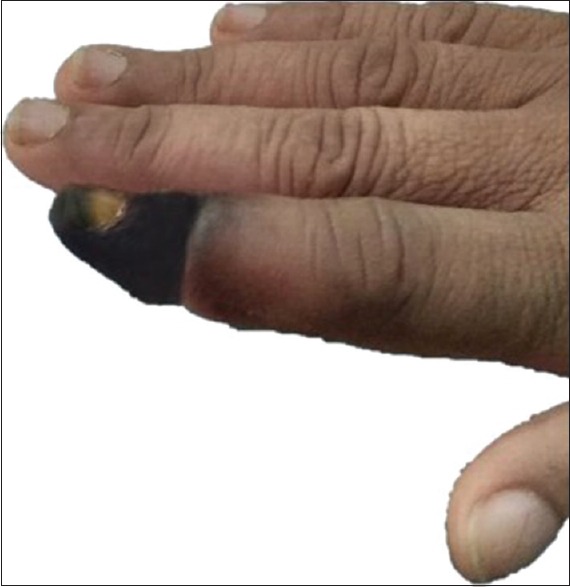
Dorsal view of affected hand before treatment
Figure 2.
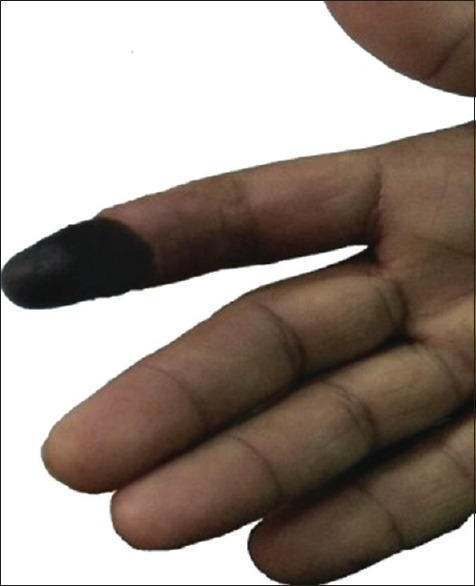
Palmar view before treatment
After confirmation of Kotha (dry gangrene), Ayurvedic treatment consisting of Kaishore Guggulu 1 g twice a day before meal with water, Sanjivani Vati 250 mg thrice a day after meal with water and Dashanga Lepa for local application twice a day with lukewarm cow Ghrita was prescribed for 1 week.
The treatment intervention was selected on the basis of clinical presentation of the Kotha (dry gangrene) condition and therapeutic properties of the drugs with possible ability to modify the same. All Ayurvedic medicines were supplied by Indian Medicines Pharmaceutical Corporation Ltd, Mohan, District Almora, Uttarakhand, to RARIDD, Gwalior. The patient showed mild improvement in the 1st week; therefore, the same medicines were continued every week and clinical improvements were observed.
Results
Initially, the patient was taking analgesic medicine as and when there was unbearable pain. The response of the Ayurvedic treatment was found highly significant. At the end of the treatment period of 2 months as compared to baseline, there was marked reduction in pain and inflammation at the site of gangrene and decrease in blackening and numbness. The patient returned to her routine work, and there was no discomfort after treatment [Figures 3–8]. There was no recurrence of symptoms in the follow-up period. Neither side effects nor complications were reported during the treatment and follow-up period.
Figure 3.
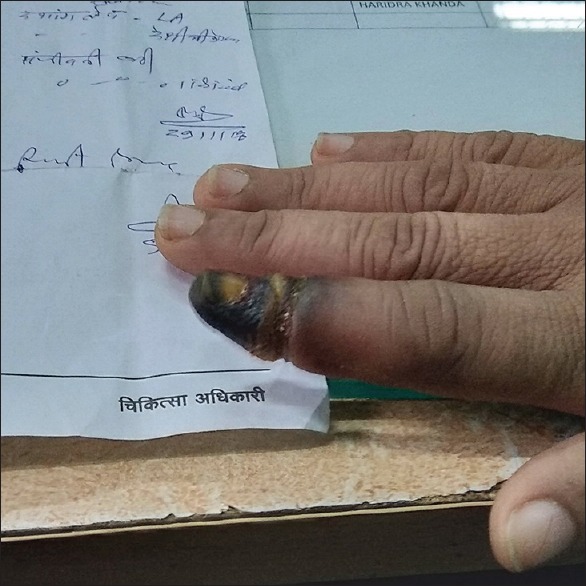
After 15 days of treatment dorsal side (dorsal side)
Figure 8.

Palmar view after treatment
Figure 4.
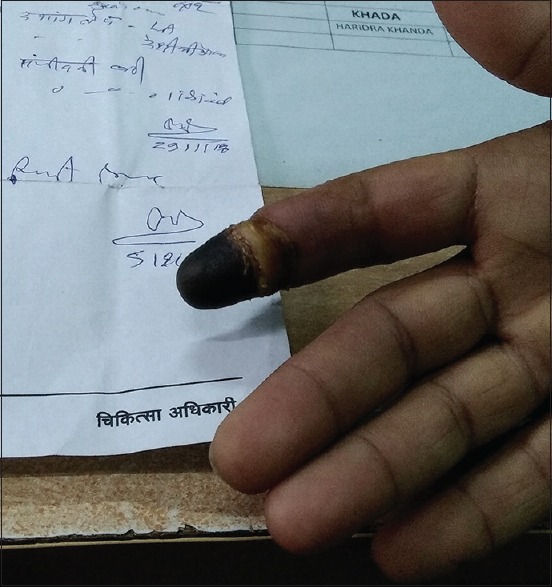
After 15 days of treatment (palmar side)
Figure 5.
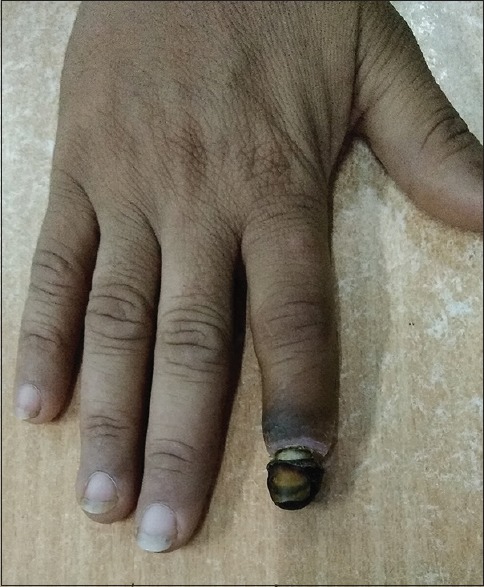
After 1 month of treatment
Figure 6.
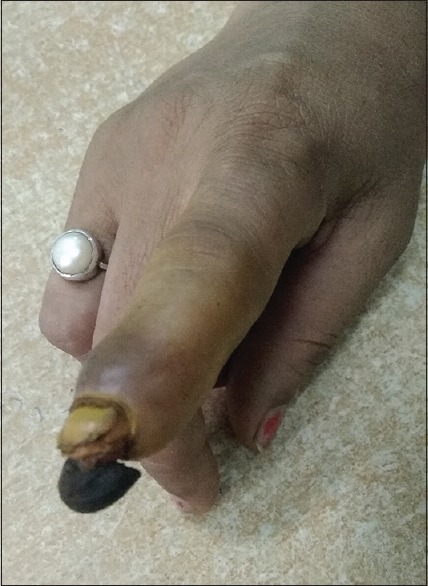
After 45 days of treatment
Figure 7.
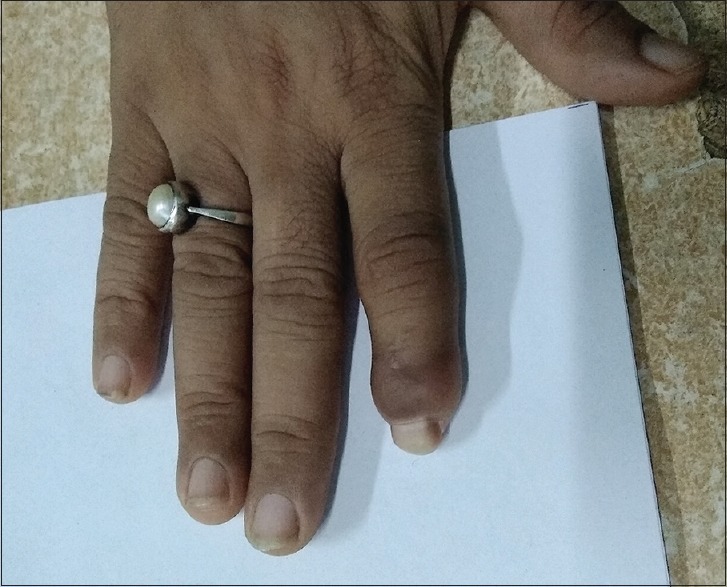
Dorsal view after treatment
Discussion
In the modern era, treatment of gangrene infections includes the removal of necrotic tissue in an attempt to allow healing of the surrounding living tissue. It is also an important step toward the prevention of further infection. The treatment options of the various types of gangrene, however, differ due to different types of conditions.[1]
In Ayurveda, gangrene can be considered as Kotha under Dushta Vrana due to Margavarana (obstruction) Dhatu Kshaya. Margavarana is caused by imbalanced Tridosha, specially Pitta and Kapha. Kaishore Guggulu balances Pitta and Kapha, particularly when it affects musculoskeletal system. Its main ingredients – Guduchi, Triphala and Trikatu –when combined with Guggulu, create a detoxifying and rejuvenating combination aimed primarily at removing deepseated Pitta from the tissues [Table1]. In Dhatu Kshaya (degenerative) condition at gangrenous part, it also acts to nourish and strengthen the system, supporting the overall health and proper function of the joints, the muscles and the connective tissue.[12] Guggulu exudate is obtained in the form of oleo gum resin from the stem of the plant Commiphora mukul (Hook. ex.). The pharmacological properties of Guggulu in Ayurveda are Tikta (bitter) in Rasa, Laghu (light) in Guna (property), Ushna (hot) in Virya (potency) and Katu (pungent) in Vipaka. Pharmacological action of Guggulu as described in Ayurveda is Brimhana (corpulent), Kaphavatahara (reduces Kapha and Vata), Pittala (increases Pitta), Vrishya (aphrodisiac), Lekhana (reduce fat), Deepana (increases gastric enzyme) and Balya (provides strength). Therapeutic indications of Guggulu are multiple according to different Ayurvedic classical textbooks such as Sthaulya (obesity), Vata Vyadhi (diseases of nervous system), Amavata (rheumatoid arthritis), Vidradhi (abscess), Udara Roga (abdominal disorders), Vatarakta (gouty arthritis), Shoph (edema), Puti Karna (otitis media) and Vrana (ulcer). Ethanolic extract of C. mukul subsided gangrene infection and also exhibited antibacterial activity.[13] An active compound, 5(1-methyl, 1-aminoethyl)-5-methyl-2-octanone, Guggulu gum also showed significant antibacterial activity against gram-positive bacteria and moderate activity against gram-negative bacteria.[14,15]
Sanjivani Vati is a diaphoretic formulation [Table 2]. It is a detoxifying formulation as well which reduces Aama. ‘Aama’ is produced due to poor digestive capacity which gets accumulated as endotoxins Roga in the body. This ‘Aama’ leads to blockage in channels and causes many diseases such as high cholesterol, blocked coronary arteries, piles, auto-immune disorders such as sarcoidosis and rheumatoid arthritis.[16] These actions of Sanjivani Vati might have cleared the blockage of arteries of gangrenous part, facilitating the blood circulation in affected area.
Dashanga Lepa reduces all cardinal features of inflammation as pain, edema, erythema and temperature. Dashanga Lepa is very effective for the management of pain. It might be due to decrease in prostaglandin level. The flavonoids (Ana Garcia-Lafuente et al., 2009) and tannin (Watson et al., 1992) present in Dashanga Lepa possess strong analgesic effect. Hence, it is possible that Dashanga Lepa has exhbited analgesic effect on inflammation. The reduction in inflammation/edema is probably due to Dhatu Shoshaka (absorptive) effect of Kashaya and Tikta Rasa (bitter taste) of most of the drugs of it [Table 3]. It alleviates vitiated Kapha to reduce the edema and it also reduces to erythema.[17] Pitta Shamaka effect of the drug can be achieved when applied with cow’s Ghrita.
Conclusion
Ayurvedic management consisting of Kaishore Guggulu, Sanjivani Vati and Dashanga Lepa was found very effective and safe in the management of case of Kotha (dry gangrene). The observed benefits may be attributed due to antiallergic, antibacterial and blood-purifying properties, skin health promoter of Kaishore Guggulu, detoxifying (Aam pachana) property of Sanjivani Vati and anti-inflammatory action of Dashanga Lepa. The findings of this case report suggest that with above Ayurvedic intervention Kotha (dry gangrene) may be managed without surgical intervention. The findings need to be confirmed and validated in more of a number of patients of gangrene.
Declaration of patient consent
The authors certify that they have obtained all appropriate patient consent forms. In the form the patient(s) has/have given his/her/their consent for his/her/their images and other clinical information to be reported in the journal. The patients understand that their names and initials will not be published and due efforts will be made to conceal their identity, but anonymity cannot be guaranteed.
Financial support and sponsorship
Nil.
Conflicts of interest
There are no conflicts of interest.
References
- 1.Brittany Stapp – Caudell. Gangrene-Recognizing and Treating Cellular Necrosis. Association of Surgical Technologists for Reprint Permission. 2008. [Last accessed on 2008 Sep 18]. p. 548. Available from: http//publications@ast.org .
- 2.Diseases and Conditions. Gangrene. 2007. [Last accessed on 2008 Sep 18]. Available from: http://publications@ast.org .
- 3.Ho H. Gas Gangrene. 2006. [Last accessed on 2008 Sep 18]. Available from: http://publications@ast.org .
- 4.National Health Portal. Gangrene. India: 2015. [Last accessed on 2017 Oct 26]. Available from: https://www.nhp.gov.in/ [Google Scholar]
- 5.Fikri R, Bicknell CD, Bloomfield LM, Lyons SP, Samarasinghe DG, Gibbs RG, et al. Awaiting autoamputation: A primary management strategy for toe gangrene in diabetic foot disease. Diabetes Care. 2011;34:e134. doi: 10.2337/dc11-0848. [DOI] [PMC free article] [PubMed] [Google Scholar]
- 6.Kalish J, Hamdan A. Management of diabetic foot problems. J Vasc Surg. 2010;51:476–86. doi: 10.1016/j.jvs.2009.08.043. [DOI] [PubMed] [Google Scholar]
- 7.Acharya YT, editor. Charaka Samhita of Agnivesha, Reprint. Varanasi: Chaukhambha Orientalia; 2009. pp. 619–738. [Google Scholar]
- 8.Rajalaxmi MG, Shrinivasa Acharya G. Dhamani Pratichaya (atherosclerosis) eventuating Vata Vyadhi (disorders caused due to Vata) Int Ayuvedic Med J. 2014;5:877–83. [Google Scholar]
- 9.Amit Lather, Vikas Gupta, Parveen Bansal, Meeta Sahu, Kamal Sachdeva, Pankaj Ghaiye. An ayurvedic polyherbal formulation Kaishore guggulu: A review. Int J Pharm Biol Arch. 2011;2:1–7. [Google Scholar]
- 10.Verma Dilip, Gupta Parul, Singh Akhilesh Kumar, Singh Om Prakash. Sanjivani vati in Ayurvedic therapeutics with special reference to Samprapti Bhang. Int J Res Ayurveda Pharm. 2011;2:1642–4. [Google Scholar]
- 11.Soni Ashish and Gupta S.J. Efficacy of Dashang Lepa in the management of Vranashopha (cellulitis) Int J Ayurvedic Med. 2013;4:227–36. [Google Scholar]
- 12.Biswas SK, Kundu S, Debnath M, Biswas M, Tuhin kanti Biswas. A review on Guggulu (Commiphera Wightii) and its market strategy. Indo Am J Pharm Sci. 2016;3:1354–60. [Google Scholar]
- 13.Sharma A, Patel VK, Rawat S, Ramteke P, Verma R. Identification of the antibacterial component of some Indian medicinal plants against Klebsiella pneumonia. Int J Pharm Pharm Sci. 2011;2:123–7. [Google Scholar]
- 14.Goyal P, Chauhan A, Kaushik P. Assessment of Commiphora wightii (Arn.) Bhandari (Guggul) as potential source for antibacterial agent. J Med Med Sci. 2010;193:71–5. [Google Scholar]
- 15.Ishnava KB, Mahida YN, Mohan JS. In vitro assessments of antibacterial potential of Commiphora wightii (Arn) Bhandari. Gum extract. J Pharm Phytother. 2010;2:91–6. [Google Scholar]
- 16.Gairola S, Gupta V, Bansal P, Maithani M, Murali Krishna C. Pharmacological activities of Sanjivani Vati. Int J Ayurvedic Med. 2010;2:1–19. [Google Scholar]
- 17.Ashish S, Gupta SJ. Efficacy of Dashang Lepa in the management of Vranashopha (cellulitis) Int J Ayurvedic Med. 2013;4:227–36. [Google Scholar]


